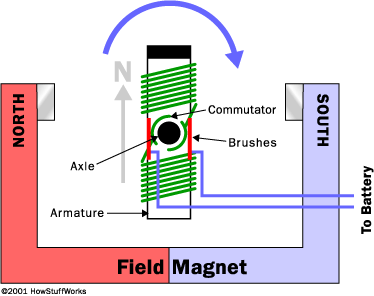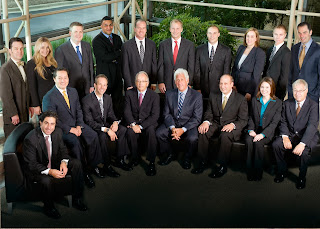 Electric Motors
Electric Motors
An Electric Motor Is An Electric Machine That Converts Electrical Energy Into Mechanical Energy.
In Normal Motoring Mode, Most Electric Motors Operate Through The Interaction Between An Electric Motor's Magnetic Field And Winding Currents To Generate Force Within The Motor. In Certain Applications, Such As In The Transportation Industry With Traction Motors, Electric Motors Can Operate In Both Motoring And Generating Or Braking Modes To Also Produce Electrical Energy From Mechanical Energy.
Found In Applications As Diverse As Industrial Fans, Blowers And Pumps, Machine Tools, Household Appliances, Power Tools, And Disk Drives, Electric Motors Can Be Powered By Direct Current (DC) Sources, Such As From Batteries, Motor Vehicles Or Rectifiers, Or By Alternating Current (AC) Sources, Such As From The Power Grid, Inverters Or Generators. Small Motors May Be Found In Electric Watches. General-Purpose Motors With Highly Standardized Dimensions And Characteristics Provide Convenient Mechanical Power For Industrial Use. The Largest Of Electric Motors Are Used For Ship Propulsion, Pipeline Compression And Pumped-Storage Applications With Ratings Reaching 100 Megawatts. Electric Motors May Be Classified By Electric Power Source Type, Internal Construction, Application, Type Of Motion Output, And So On.
Devices Such As Magnetic Solenoids And Loudspeakers That Convert Electricity Into Motion But Do Not Generate Usable Mechanical Power Are Respectively Referred To As Actuators And Transducers. Electric Motors Are Used To Produce Linear Force Or Torque (Rotary).
In Normal Motoring Mode, Most Electric Motors Operate Through The Interaction Between An Electric Motor's Magnetic Field And Winding Currents To Generate Force Within The Motor. In Certain Applications, Such As In The Transportation Industry With Traction Motors, Electric Motors Can Operate In Both Motoring And Generating Or Braking Modes To Also Produce Electrical Energy From Mechanical Energy.
Found In Applications As Diverse As Industrial Fans, Blowers And Pumps, Machine Tools, Household Appliances, Power Tools, And Disk Drives, Electric Motors Can Be Powered By Direct Current (DC) Sources, Such As From Batteries, Motor Vehicles Or Rectifiers, Or By Alternating Current (AC) Sources, Such As From The Power Grid, Inverters Or Generators. Small Motors May Be Found In Electric Watches. General-Purpose Motors With Highly Standardized Dimensions And Characteristics Provide Convenient Mechanical Power For Industrial Use. The Largest Of Electric Motors Are Used For Ship Propulsion, Pipeline Compression And Pumped-Storage Applications With Ratings Reaching 100 Megawatts. Electric Motors May Be Classified By Electric Power Source Type, Internal Construction, Application, Type Of Motion Output, And So On.
Devices Such As Magnetic Solenoids And Loudspeakers That Convert Electricity Into Motion But Do Not Generate Usable Mechanical Power Are Respectively Referred To As Actuators And Transducers. Electric Motors Are Used To Produce Linear Force Or Torque (Rotary).
 Early motors
Early motors
Perhaps The First Electric Motors Were Simple Electrostatic Devices Created By The Scottish Monk Andrew Gordon In The 1740s.The Theoretical Principle Behind Production Of Mechanical Force By The Interactions Of An Electric Current And A Magnetic Field, Ampère's Force Law, Was Discovered Later By André-Marie Ampère In 1820. The Conversion Of Electrical Energy Into Mechanical Energy By Electromagnetic Means Was Demonstrated By The British Scientist Michael Faraday In 1821. A Free-Hanging Wire Was Dipped Into A Pool Of Mercury, On Which A Permanent Magnet (PM) Was Placed. When A Current Was Passed Through The Wire, The Wire Rotated Around The Magnet, Showing That The Current Gave Rise To A Close Circular Magnetic Field Around The Wire.This Motor Is Often Demonstrated In Physics Experiments, Brine Substituting For Toxic Mercury. Though Barlow's Wheel Was An Early Refinement To This Faraday Demonstration, These And Similar Homopolar Motors Were To Remain Unsuited To Practical Application Until Late In The Century.
Jedlik's "Electromagnetic Self-Rotor", 1827 (Museum Of Applied Arts, Budapest). The Historic Motor Still Works Perfectly Today.
In 1827, Hungarian Physicist Ányos Jedlik Started Experimenting With Electromagnetic Coils. After Jedlik Solved The Technical Problems Of The Continuous Rotation With The Invention Of Commutator, He Called His Early Devices As "Electromagnetic Self-Rotors". Although They Were Used Only For Instructional Purposes, In 1828 Jedlik Demonstrated The First Device To Contain The Three Main Components Of Practical DC Motors: The Stator, Rotor And Commutator. The Device Employed No Permanent Magnets, As The Magnetic Fields Of Both The Stationary And Revolving Components Were Produced Solely By The Currents Flowing Through Their Windings.
Jedlik's "Electromagnetic Self-Rotor", 1827 (Museum Of Applied Arts, Budapest). The Historic Motor Still Works Perfectly Today.
In 1827, Hungarian Physicist Ányos Jedlik Started Experimenting With Electromagnetic Coils. After Jedlik Solved The Technical Problems Of The Continuous Rotation With The Invention Of Commutator, He Called His Early Devices As "Electromagnetic Self-Rotors". Although They Were Used Only For Instructional Purposes, In 1828 Jedlik Demonstrated The First Device To Contain The Three Main Components Of Practical DC Motors: The Stator, Rotor And Commutator. The Device Employed No Permanent Magnets, As The Magnetic Fields Of Both The Stationary And Revolving Components Were Produced Solely By The Currents Flowing Through Their Windings.
Success with DC motors
The First Commutator DC Electric Motor Capable Of Turning Machinery Was Invented By The British Scientist William Sturgeon In 1832. Following Sturgeon's Work, A Commutator-Type Direct-Current Electric Motor Made With The Intention Of Commercial Use Was Built By The American Inventor Thomas Davenport, Which He Patented In 1837. The Motors Ran At Up To 600 Revolutions Per Minute, And Powered Machine Tools And A Printing Press. Due To The High Cost Of Primary Battery Power, The Motors Were Commercially Unsuccessful And Davenport Went Bankrupt. Several Inventors Followed Sturgeon In The Development Of DC Motors But All Encountered The Same Battery Power Cost Issues. No Electricity Distribution Had Been Developed At The Time. Like Sturgeon's Motor, There Was No Practical Commercial Market For These Motors.
In 1855, Jedlik Built A Device Using Similar Principles To Those Used In His Electromagnetic Self-Rotors That Was Capable Of Useful Work. He Built A Model Electric Vehicle That Same Year.
The First Commercially Successful DC Motors Followed The Invention By Zénobe Gramme Who Had In 1871 Developed The Anchor Ring Dynamo Which Solved The Double-T Armature Pulsating DC Problem. In 1873, Gramme Found That This Dynamo Could Be Used As A Motor, Which He Demonstrated To Great Effect At Exhibitions In Vienna And Philadelphia By Connecting Two Such DC Motors At A Distance Of Up To 2 Km Away From Each Other, One As A Generator. (See Also 1873 : L'expérience Décisive [Decisive Workaround] .)
In 1886, Frank Julian Sprague Invented The First Practical DC Motor, A Non-Sparking Motor That Maintained Relatively Constant Speed Under Variable Loads. Other Sprague Electric Inventions About This Time Greatly Improved Grid Electric Distribution (Prior Work Done While Employed By Thomas Edison), Allowed Power From Electric Motors To Be Returned To The Electric Grid, Provided For Electric Distribution To Trolleys Via Overhead Wires And The Trolley Pole, And Provided Controls Systems For Electric Operations. This Allowed Sprague To Use Electric Motors To Invent The First Electric Trolley System In 1887–88 In Richmond VA, The Electric Elevator And Control System In 1892, And The Electric Subway With Independently Powered Centrally Controlled Cars, Which Were First Installed In 1892 In Chicago By The South Side Elevated Railway Where It Became Popularly Known As The "L". Sprague's Motor And Related Inventions Led To An Explosion Of Interest And Use In Electric Motors For Industry, While Almost Simultaneously Another Great Inventor Was Developing Its Primary Competitor, Which Would Become Much More Widespread. The Development Of Electric Motors Of Acceptable Efficiency Was Delayed For Several Decades By Failure To Recognize The Extreme Importance Of A Relatively Small Air Gap Between Rotor And Stator. Efficient Designs Have A Comparatively Small Air Gap. The St. Louis Motor, Long Used In Classrooms To Illustrate Motor Principles, Is Extremely Inefficient For The Same Reason, As Well As Appearing Nothing Like A Modern Motor.
Application Of Electric Motors Revolutionized Industry. Industrial Processes Were No Longer Limited By Power Transmission Using Line Shafts, Belts, Compressed Air Or Hydraulic Pressure. Instead Every Machine Could Be Equipped With Its Own Electric Motor, Providing Easy Control At The Point Of Use, And Improving Power Transmission Efficiency. Electric Motors Applied In Agriculture Eliminated Human And Animal Muscle Power From Such Tasks As Handling Grain Or Pumping Water. Household Uses Of Electric Motors Reduced Heavy Labor In The Home And Made Higher Standards Of Convenience, Comfort And Safety Possible. Today, Electric Motors Stand For More Than Half Of The Electric Energy Consumption In The US.
In 1855, Jedlik Built A Device Using Similar Principles To Those Used In His Electromagnetic Self-Rotors That Was Capable Of Useful Work. He Built A Model Electric Vehicle That Same Year.
The First Commercially Successful DC Motors Followed The Invention By Zénobe Gramme Who Had In 1871 Developed The Anchor Ring Dynamo Which Solved The Double-T Armature Pulsating DC Problem. In 1873, Gramme Found That This Dynamo Could Be Used As A Motor, Which He Demonstrated To Great Effect At Exhibitions In Vienna And Philadelphia By Connecting Two Such DC Motors At A Distance Of Up To 2 Km Away From Each Other, One As A Generator. (See Also 1873 : L'expérience Décisive [Decisive Workaround] .)
In 1886, Frank Julian Sprague Invented The First Practical DC Motor, A Non-Sparking Motor That Maintained Relatively Constant Speed Under Variable Loads. Other Sprague Electric Inventions About This Time Greatly Improved Grid Electric Distribution (Prior Work Done While Employed By Thomas Edison), Allowed Power From Electric Motors To Be Returned To The Electric Grid, Provided For Electric Distribution To Trolleys Via Overhead Wires And The Trolley Pole, And Provided Controls Systems For Electric Operations. This Allowed Sprague To Use Electric Motors To Invent The First Electric Trolley System In 1887–88 In Richmond VA, The Electric Elevator And Control System In 1892, And The Electric Subway With Independently Powered Centrally Controlled Cars, Which Were First Installed In 1892 In Chicago By The South Side Elevated Railway Where It Became Popularly Known As The "L". Sprague's Motor And Related Inventions Led To An Explosion Of Interest And Use In Electric Motors For Industry, While Almost Simultaneously Another Great Inventor Was Developing Its Primary Competitor, Which Would Become Much More Widespread. The Development Of Electric Motors Of Acceptable Efficiency Was Delayed For Several Decades By Failure To Recognize The Extreme Importance Of A Relatively Small Air Gap Between Rotor And Stator. Efficient Designs Have A Comparatively Small Air Gap. The St. Louis Motor, Long Used In Classrooms To Illustrate Motor Principles, Is Extremely Inefficient For The Same Reason, As Well As Appearing Nothing Like A Modern Motor.
Application Of Electric Motors Revolutionized Industry. Industrial Processes Were No Longer Limited By Power Transmission Using Line Shafts, Belts, Compressed Air Or Hydraulic Pressure. Instead Every Machine Could Be Equipped With Its Own Electric Motor, Providing Easy Control At The Point Of Use, And Improving Power Transmission Efficiency. Electric Motors Applied In Agriculture Eliminated Human And Animal Muscle Power From Such Tasks As Handling Grain Or Pumping Water. Household Uses Of Electric Motors Reduced Heavy Labor In The Home And Made Higher Standards Of Convenience, Comfort And Safety Possible. Today, Electric Motors Stand For More Than Half Of The Electric Energy Consumption In The US.




.jpg)


.jpg)
.jpg)





.jpg)
.jpg)
.jpg)
.jpg)




